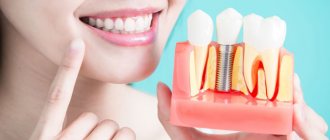Oncological alertness in dentistry
Early and timely diagnosis of precancerous diseases and adequate treatment can serve as a real basis for the prevention of cancer of the maxillofacial area, oral mucosa, tongue and lips.
A person comes into contact with the outside world through the oral cavity; accordingly, it is there that inflammatory processes are most likely to occur, which can become the main factors in the development of a tumor.
Oncology of the maxillofacial region accounts for about 15% of tumors in the human body. Cancer of the red border of the lips and oral mucosa (ORM) accounts for about 5% of all malignant tumors.
The importance of timely diagnosis of these tumors is determined not only by the frequency of cases, but also by the peculiarities of the course of these forms of cancer. Despite the fact that tumors of the maxillofacial region are easily accessible for examination and do not require complex diagnostic methods, half of the patients die very quickly, since this group of neoplasms belongs to high-grade tumors that grow quickly and metastasize early.
Precancer is a condition that turns into cancer as a result of a constant change in the properties of cells towards malignancy. Precancer turns into cancer not so much as a result of qualitative changes (time, mass), but rather as a result of changes in the biological essence of cells, the accumulation in them of properties inherent in a malignant cell.
For early diagnosis and detection of diseases, it is important to know the conditions of precancers of the oral mucosa, red border of the lips and skin, as well as the factors contributing to their occurrence.
Factors contributing to the occurrence of precancerous conditions:
- Mechanical irritants : malocclusion, incorrect position of individual teeth, poorly made restorations and dentures, pathological abrasion of teeth, bad habits (holding a pencil, pen, nails, etc. in the mouth).
- Household chemical irritants : spices, highly concentrated solutions of ethyl alcohol, tobacco. The latter has a gross irritating effect on the oral mucosa. When smoking, approximately 20% of tobacco smoke enters the body, which contains a number of products that are extremely irritating: pyridine bases (the transition of nicotine to pyridine is the most harmful side of the action), hydrocyanic acid, cyanide compounds, fatty acids, phenol and tar sediment . Tobacco smoke also contains benzopyrene and arsenic. One of the irritating aspects of smoking is the thermal factor.
- Industrial irritants: alkalis, acids in the form of vapors and aerosols, other chemicals.
- Chronic thermal injury : hot food, repeated exposure to elevated temperatures when smoking: burning the lips with a cigarette (in the tobacco combustion zone the temperature reaches 4000 C), hot air when working in some enterprises.
- Meteorological irritants : a complex of unfavorable environmental factors. These include exposure to sunlight, dust, wind, salt water aerosols in conditions of low temperature and high humidity.
- Biological irritants : these include a number of microorganisms that are pathogenic for humans (yeast-like fungi that cause increased keratinization of the mucous membrane of the tongue, pale spirochete, Koch's bacillus).
- Ionizing radiation : this factor should be taken into account in patients receiving radiation therapy for tumors of one location or another, during which the surrounding mucous membrane of the oral cavity enters the irradiation zone.
One of the main causes of cancer of the maxillofacial area is the unsatisfactory condition of the oral cavity, especially the presence of carious teeth and bad dentures, sharp edges that constantly injure the mucous membrane, causing bedsores and long-term non-healing ulcers.
Signs of malignancy of precancerous conditions:
- Long, sluggish course of the process (the presence of an ulcer that does not heal within 2-3 weeks);
- Failure of conservative treatment;
- An increase in the size of the pathological lesion, despite adequate treatment;
- The appearance of a compaction around or at the base of the pathological focus;
- Bleeding;
- The appearance of dense, enlarged, painless regional lymph nodes.
- The appearance of mobility of one or more intact teeth, accompanied by constant pain;
- Gradually increasing paresis of facial muscles, parasthesia and numbness in the area of the infraorbital and mental nerves;
- The appearance of a formation on the lips or in the oral cavity that does not go away for a long time and tends to increase in size, it can be: a red spot, a whitish spot, an ulcer, a thickening, a growth.
The most reliable prevention of cancer is the elimination of factors favorable to its development and radical treatment of people with precancerous conditions.
An effective means of preventing precancerous conditions of the tongue and oral mucosa is daily oral hygiene, eliminating the dangers associated with carious teeth and low-quality dentures.
Dentist
Elena Gurin
Oncological alertness in dentistry - you still have time
A person comes into contact with the outside world through the oral cavity; accordingly, it is there that inflammatory processes are most likely to develop, which can become the main factors in the development of a tumor.
Cancer of the red border of the lips and oral mucosa (ORM) accounts for about 5% of all malignant tumors.
Oral cancer develops in men 3 times more often than in women. People aged 60-70 years are most often affected. Over the age of 40, the number of cases increases and decreases significantly after 80 years. Numerous experiences in studying malignant tumors have shown that in most patients they develop on pathologically altered tissues. Most often these are long-term inflammatory processes of various etiologies and precancers.
Precancer is a dynamic condition that turns into cancer as a result of a constant change in the properties of cells towards malignancy. Precancer turns into cancer not so much as a result of qualitative changes (time, mass), but rather as a result of changes in the biological essence of cells, the accumulation in them of properties inherent in a malignant cell.
Factors contributing to the occurrence of precancerous conditions
- Mechanical irritants: malocclusion, incorrect position of individual teeth, poorly made restorations and dentures, pathological abrasion of teeth, bad habits (holding a pencil, pen, nails, etc. in the mouth).
- Household chemical irritants: spices, highly concentrated solutions of ethyl alcohol, tobacco. The latter has a gross irritating effect on the oral mucosa. When smoking, approximately 20% of tobacco smoke enters the body, which contains a number of products that are extremely irritating: pyridine bases (the transition of nicotine to pyridine is the most harmful side of the action), hydrocyanic acid, cyanide compounds, fatty acids, phenol and tar sediment. Tobacco smoke also contains benzopyrene and arsenic. One of the irritating aspects of smoking is the thermal factor.
- Industrial irritants: alkalis, acids in the form of vapors and aerosols, other chemicals.
- Chronic thermal injury: hot food, repeated exposure to elevated temperatures when smoking: burning the lips with a cigarette (in the tobacco combustion zone the temperature reaches 4000C), hot air when working in some enterprises.
- Meteorological: represent a complex of unfavorable environmental factors. These include exposure to sunlight, dust, wind, salt water aerosols in conditions of low temperature and high humidity.
- Biological: these include a number of microorganisms pathogenic for humans (yeast-like fungi that cause increased keratinization of the mucous membrane of the tongue, pale spirochete, Koch's bacillus).
- Ionizing radiation: this factor should be taken into account in patients receiving radiation therapy for tumors of one location or another, during which the surrounding mucous membrane of the oral cavity enters the irradiation zone.
In addition to external factors, there are also anatomical and physiological prerequisites. The main one is the tendency of the oral mucosa to increased keratinization. The tendency towards keratinization increases with age.
- Stressful conditions: the role of acute mental trauma in the occurrence of precancers can be seen in the example of lichen planus.
- Diseases of the gastrointestinal tract. With chronic gastritis, enteritis, and colitis, para- or hyperkeratoses develop.
- Feverish conditions.
- Dryness of the oral mucosa of various etiologies.
- Lupus erythematosus, psoriasis, ichthyosis.
SIGNS OF MALIGNANCE OF PRE-CANCEROR CONDITIONS
- Long, sluggish course of the process;
- Failure of conservative treatment;
- An increase in the size of the pathological lesion, despite adequate treatment;
- The appearance of a compaction around or at the base of the pathological focus;
- Bleeding;
- The appearance of dense, enlarged, painless regional lymph nodes.
Treatment results
The results of treatment for cancer of the oral mucosa of the first and second stages (tumor size no more than 4 cm) are 60-94% of the 5-year cure rate for stage 1 cancer, up to 65% for stage 2 cancer.
Treatment results for stage 3 cancer range from 15 to 37%.
In stage 4 cancer, cure can only be achieved in some patients.
Oncological alertness
No matter what complaints the patient comes with, examination of the entire oral cavity and the red border of the lips is the law for the doctor. Any deviation from the norm should attract the close attention of a specialist. Early manifestations of cancer may go unnoticed by the patient, and it is the doctor’s duty to identify them in a timely manner as early as possible. In difficult diagnostic cases, one should think about the possibility of growth of a malignant tumor and make a diagnosis as soon as possible. Treatment without diagnosis should not last more than 7 days. Local irritants should be eliminated and agents that promote tumor growth should not be used (cauterization, physiotherapy, etc.). In difficult cases, the doctor is obliged to involve more experienced specialists in examining the patient.
The most reliable prevention of cancer is the elimination of factors favorable to its development and radical treatment of people with precancerous conditions.
An effective means of preventing precancerous conditions of the tongue and oral mucosa is daily oral hygiene, eliminating the dangers associated with carious teeth and low-quality dentures.
Where is implantation performed for oncology?
The intake of necessary nutrients into the body promotes recovery, but it is impossible without the normal functioning of the masticatory apparatus. Therefore, restoring chewing function to the maximum extent possible is the primary task that the installation of implants solves. At the same time, atrophy, thinning, fragility of bone tissue and other consequences of cancer, chemotherapy and radiation treatment seriously complicate dental implantation. That is why only the luminaries of implantology, specialists of the highest category, who have not only deep knowledge, but also extensive practical experience, undertake the treatment of patients with oncological diseases. The New White Smile Clinic is one of the few dentists in Moscow where the level of implantologists is so high that it allows dental implantation in complex clinical cases, which include cancer. The clinic’s doctors are ready to help patients who have survived a terrible disease return to normal life.
Implantation during remission
To minimize the likelihood of rejection of implants installed after successful treatment of a serious illness, it makes sense to opt for gentle implantation techniques that are less invasive than the classic protocol.
- Single-phase implantation
Suitable for patients who are missing several teeth. The principle of implantation is without incisions, only through thin punctures in the mucous membrane. The wound surface is minimal. Healing is very fast and easy. This is an immediate loading implantation protocol in which the patient immediately receives a temporary prosthesis. It is involved in chewing and provides load on bone tissue, promoting better nutrition and regeneration.
- Complete prosthetics on All-on-4 (All-on-6) implants
The method is suitable for patients who have lost a large number of teeth, or those remaining after cancer treatment in such a condition that they require removal. The protocol involves installing 4 or 6 implants in a completely empty jaw, followed by fixing a complete denture of 10-12 teeth on them. This operation uses small implants; their installation causes significant trauma to the bone tissue. The prosthesis is fixed on the day of installation and implants, and after 3-4 days the patient fully uses the new teeth.
Oncological process as an absolute contraindication to implantation
The progressive development of the oncological process is a contraindication to the installation of dental implants. Implant treatment requires good health. Very often, the development of the disease is associated with exhaustion and destruction of the patient’s body. The body protects itself and, in the fight against tumor diseases, devotes all its resources to maintaining the proper functioning of all life systems.
An additional risk for implant osseointegration is therapy performed during cancer treatment. Contraindications for implantation are chemotherapy, radiation therapy and surgical treatment, which reduce overall immunity. In addition, they cause the death of cells, including those responsible for immunity, and may be an indirect cause of infection of the tissues around the implant after its implantation.
During the period of remission, when health indicators have stabilized, an attempt at implantation can be made. But it is important to understand that the risks in this case are slightly higher than in patients without a history of cancer.










